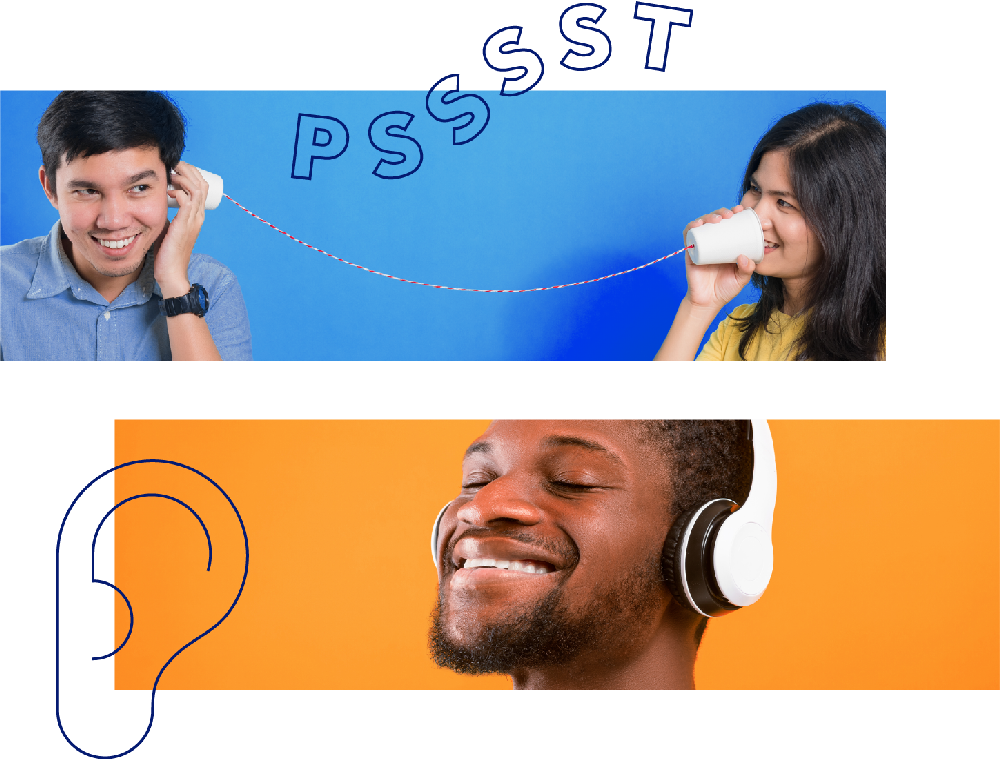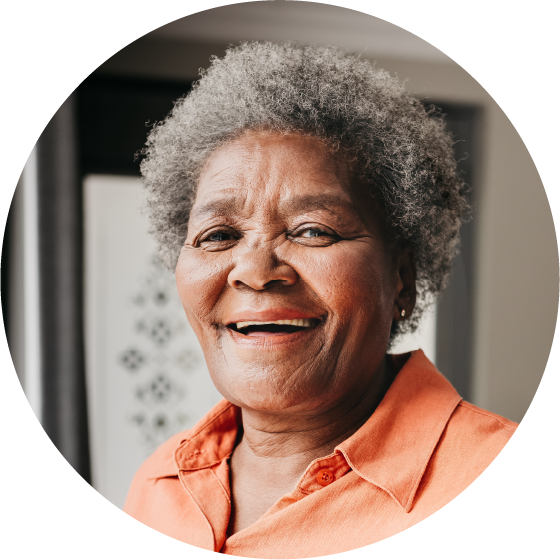Talk About Hearing
What is the Hearing Number?
The Hearing Number is a simple way for your patients to understand and monitor their hearing throughout their lives. The Hearing Number is known clinically as the 4-frequency pure tone average, or the PTA4, which is the basis of the World Health Organization’s classification system for hearing.
The Hearing Number indicates in decibels, or dB, the softest speech sound someone can hear. Everyone has two Hearing Numbers: one for their right ear and one for their left ear. The numbers can be as low as -10 dB and as high as 85 dB or more. Children often have Hearing Numbers close to 0 dB, but everyone’s Hearing Numbers will increase over their lifetime with age-related changes in hearing.
Encouraging a patient to know their Hearing Numbers empowers them to take steps to protect or optimize their hearing over their lifetime.
Download our educational factsheet to share this information with your patients.

Communication Experience and Strategies for Hearing Better
Explore by Hearing Number range in the better-performing ear.
Normal Hearing
Typical Hearing Experience
In Quiet:
No problems hearing sounds
In Background Noise:
No or minimal problems hearing conversational speech
Strategies
Communication strategies, Everyday technologies, OTC hearing aids
Slight hearing loss
Typical Hearing Experience
In Quiet:
No problems hearing conversational speech
In Background Noise:
Difficulty hearing conversational speech
Strategies
Communication strategies, Everyday technologies, OTC hearing aids, Prescription hearing aids
Moderate hearing loss
Typical Hearing Experience
In Quiet:
Difficulty hearing conversational speech
In Background Noise:
Difficulty hearing and taking part in conversation
Strategies
Communication strategies, Everyday technologies, OTC hearing aids, Prescription hearing aids
Moderately severe hearing loss
Typical Hearing Experience
In Quiet:
Difficulty hearing conversational speech; can hear raised voices
In Background Noise:
Difficulty hearing most speech and taking part in conversation
Strategies
Communication strategies, Everyday technologies, OTC hearing aids, Prescription hearing aids
Severe hearing loss
Typical Hearing Experience
In Quiet:
Cannot hear most conversational speech; difficulty hearing and understanding raised voices
In Background Noise:
Extreme difficulty hearing speech and taking part in conversation
Strategies
Communication strategies, Everyday technologies, Prescription hearing aids, Cochlear implants
Profound or complete hearing loss
Typical Hearing Experience
In Quiet:
Extreme difficulty hearing raised voices
In Background Noise:
Cannot hear conversational speech
Strategies
Communication strategies, Everyday technologies, Prescription hearing aids, Cochlear implants
How can my patients learn their Hearing Numbers?
- Take a short hearing test on the Hearing Number app. Patients can accurately measure their Hearing Numbers by using the Johns Hopkins Bloomberg School of Public Health Hearing Number app. It is free for iOS and Android. Patients can also learn their Hearing Numbers with the Mimi or Jacoti apps if they have an Apple iPhone or iPad.
- Use Apple’s hearing test. Patients with AirPods Pro 2 and an iPhone or iPad can learn their Hearing Numbers with the clinical-grade Apple hearing test.
- See a hearing care professional. A hearing care professional, such as an audiologist, can evaluate your patients’ hearing and give them their PTA4, which is the Hearing Number.
Why should I talk to my patients about the Hearing Number?
Hearing is often neglected as a facet of health until patients are older or have substantial hearing issues. In reality, hearing changes throughout life, and patients can take steps to protect their hearing and hear better along the way. Hearing is foundational to social and cognitive health, and for older adults, there is evidence that treating hearing loss may slow cognitive decline. Yet, many people do not know much about their hearing.
Encouraging your patients to know their Hearing Numbers gives you both an understanding of a critical aspect of their health similar to height, weight, or blood pressure. It can empower your patients to begin thinking and acting on this aspect of their health over their lifetime. And it can help you guide them to strategies that can protect and optimize their hearing.
For a teenager or young adult, learning that their Hearing Numbers have likely already changed since they were younger could mean taking steps to protect their hearing against harmful noise exposure.
For mid-life to older adults, this could mean noticing how it becomes more difficult to understand speech in noisy places, like a busy restaurant, as their Hearing Numbers increase over time. Knowing their Hearing Numbers can point them to technologies and strategies that can help them hear and communicate better.
Hearing loss is associated with social isolation and loneliness.1
Hearing loss is linked to loss of thinking and memory abilities.2
Hearing loss is the single greatest risk factor for dementia.3
In older adults at increased risk for cognitive decline, hearing intervention slowed down loss of thinking and memory abilities by 48% over three years.4
Your patients’ Hearing Numbers can guide them to strategies to protect their hearing and hear better. Usually, the higher their Hearing Numbers are, the more communication strategies and technologies they may need to hear better.
The Hearing Number in practice

Kelly, 16, comes for her annual pediatric check-up. She often goes to concerts with her friends and sometimes hears ringing in her ears afterward. After Kelly’s doctor encourages her to learn her Hearing Numbers on her smartphone, Kelly becomes aware of her hearing and how her Hearing Numbers can even become acutely worse for a short period after exposure to loud music that stuns the inner ear. Kelly begins using fashionable earplugs when attending concerts and notices that she no longer has ringing in her ears the next day.

Mateo, 49, presents for his annual medical exam. He has no concerns about his hearing but mentions that in certain settings, like noisy restaurants, it’s harder to communicate. Encouraged by his doctor to test his hearing using his smartphone, Mateo learns his Hearing Numbers are 19 dB in each ear, which, while still being considered in the normal range, is a big difference from his 15-year-old son’s hearing of -3 dB. He decides to turn on the amplification feature in his earbuds and finds that they help in these situations.

Simone, 71, comes for her annual Medicare wellness exam. She shares concerns about her hearing given media reports of how hearing is linked to dementia risk. She’s never had a hearing test. Her doctor encourages her to use an app on her smartphone to learn her Hearing Numbers, which gives her a better understanding of her hearing. Simone elects to follow up with an audiologist for additional evaluation and counseling about options to optimize her hearing.

Kelly, 16, comes for her annual pediatric check-up. She often goes to concerts with her friends and sometimes hears ringing in her ears afterward. After Kelly’s doctor encourages her to learn her Hearing Numbers on her smartphone, Kelly becomes aware of her hearing and how her Hearing Numbers can even become acutely worse for a short period after exposure to loud music that stuns the inner ear. Kelly begins using fashionable earplugs when attending concerts and notices that she no longer has ringing in her ears the next day.

Mateo, 49, presents for his annual medical exam. He has no concerns about his hearing but mentions that in certain settings, like noisy restaurants, it’s harder to communicate. Encouraged by his doctor to test his hearing using his smartphone, Mateo learns his Hearing Numbers are 19 dB in each ear, which, while still being considered in the normal range, is a big difference from his 15-year-old son’s hearing of -3 dB. He decides to turn on the amplification feature in his earbuds and finds that they help in these situations.

Simone, 71, comes for her annual Medicare wellness exam. She shares concerns about her hearing given media reports of how hearing is linked to dementia risk. She’s never had a hearing test. Her doctor encourages her to use an app on her smartphone to learn her Hearing Numbers, which gives her a better understanding of her hearing. Simone elects to follow up with an audiologist for additional evaluation and counseling about options to optimize her hearing.
How should I talk about the Hearing Number?
- The Hearing Number gives a snapshot of someone’s hearing and indicates the softest speech sound they can hear in each ear. Hearing is on a continuum. Hearing is not a binary where someone either has hearing or they have hearing loss. Hearing changes over time, and people experience hearing along a spectrum as it changes.
- The Hearing Number is one facet of someone’s hearing health, and it provides insights into a person’s daily hearing experience. Hearing care professionals—audiologists, and ENTs/otolaryngologists—can provide full assessments of hearing.
- The Hearing Number cannot be lowered or improved, and there is no “perfect score.” Everyone’s hearing changes over time because parts of the inner ear wear out. No hearing technology, including prescription and over-the-counter hearing aids and cochlear implants, can undo those biological changes. But communications strategies and technologies can help people hear and communicate better, whatever their Hearing Numbers are.

Why is the Hearing Number based on the 4-frequency pure tone average (PTA4)?
The PTA4 is calculated from an audiogram and does not depend on language. This number directly indicates how well someone can hear speech and is the basis of the World Health Organization’s classification system for hearing. Along with the audiogram, a hearing specialist can also measure other aspects of hearing (for example, speech and other tests of the middle and inner ear function).
- Hearing loss, loneliness, and social isolation: A systematic review. Otolaryngology—Head and Neck Surgery, 2020.
- Age-related hearing loss and cognitive decline: MRI and cellular evidence. Annals of the New York Academy of Sciences, 2021.
- Dementia prevention, intervention, and care: 2020 report of the Lancet Commission. The Lancet, 2020; Dementia prevention, intervention, and care: 2024 report of the Lancet Commission. The Lancet, 2024.
- Hearing intervention versus health education control to reduce cognitive decline in older adults with hearing loss in the USA (ACHIEVE): a multicentre, randomised controlled trial. The Lancet, 2023.